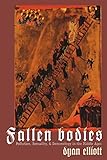Fallen Bodies : Pollution, Sexuality, and Demonology in the Middle Ages / Dyan Elliott.
Material type: TextSeries: The Middle Ages SeriesPublisher: Philadelphia : University of Pennsylvania Press, [2010]Copyright date: ©1998Description: 1 online resource (312 p.)Content type:
TextSeries: The Middle Ages SeriesPublisher: Philadelphia : University of Pennsylvania Press, [2010]Copyright date: ©1998Description: 1 online resource (312 p.)Content type: - 9780812216653
- 9780812200737
- 261.8/357/0902 21
- BT708 .E43 1999
- online - DeGruyter
| Item type | Current library | Call number | URL | Status | Notes | Barcode | |
|---|---|---|---|---|---|---|---|
 eBook
eBook
|
Biblioteca "Angelicum" Pont. Univ. S.Tommaso d'Aquino Nuvola online | online - DeGruyter (Browse shelf(Opens below)) | Online access | Not for loan (Accesso limitato) | Accesso per gli utenti autorizzati / Access for authorized users | (dgr)9780812200737 |
Browsing Biblioteca "Angelicum" Pont. Univ. S.Tommaso d'Aquino shelves, Shelving location: Nuvola online Close shelf browser (Hides shelf browser)

|

|

|

|

|

|

|
||
| online - DeGruyter The Promised Lands : The Low Countries Under Burgundian Rule, 1369-1530 / | online - DeGruyter The Arabic Role in Medieval Literary History : A Forgotten Heritage / | online - DeGruyter The Sex Lives of Saints : An Erotics of Ancient Hagiography / | online - DeGruyter Fallen Bodies : Pollution, Sexuality, and Demonology in the Middle Ages / | online - DeGruyter The Fantasy Factory : An Insider's View of the Phone Sex Industry / | online - DeGruyter Beverly Hills, 90210 : Television, Gender, and Identity / | online - DeGruyter Cultures of Power : Lordship, Status, and Process in Twelfth-Century Europe / |
Frontmatter -- Contents -- Acknowledgments -- Abbreviations -- Introduction -- 1. Pollution, Illusion, and Masculine Disarray: Nocturnal Emissions and the Sexuality of the Clergy -- 2. From Sexual Fantasy to Demonic Defloration: The Libidinous Female in the Later Middle Ages -- 3. Sex in Holy Places: An Exploration of a Medieval Anxiety -- 4. The Priest's Wife: Female Erasure and the Gregorian Reform -- 5. Avatars of the Priest's Wife: The Return of the Repressed -- 6. On Angelic Disembodiment and the Incredible Purity of Demons -- Afterword -- Notes -- Bibliography -- Index
restricted access online access with authorization star
http://purl.org/coar/access_right/c_16ec
Medieval clerics believed that original sin had rendered their "fallen bodies" vulnerable to corrupting impulses—particularly those of a sexual nature. They feared that their corporeal frailty left them susceptible to demonic forces bent on penetrating and polluting their bodies and souls.Drawing on a variety of canonical and other sources, Fallen Bodies examines a wide-ranging set of issues generated by fears of pollution, sexuality, and demonology. To maintain their purity, celibate clerics combated the stain of nocturnal emissions; married clerics expelled their wives onto the streets and out of the historical record; an exemplum depicting a married couple having sex in church was told and retold; and the specter of the demonic lover further stigmatized women's sexuality. Over time, the clergy's conceptions of womanhood became radically polarized: the Virgin Mary was accorded ever greater honor, while real, corporeal women were progressively denigrated. When church doctrine definitively denied the physicality of demons, the female body remained as the prime material presence of sin.Dyan Elliott contends that the Western clergy's efforts to contain sexual instincts—and often the very thought and image of woman—precipitated uncanny returns of the repressed. She shows how this dynamic ultimately resulted in the progressive conflation of the female and the demonic, setting the stage for the future persecution of witches.
Mode of access: Internet via World Wide Web.
In English.
Description based on online resource; title from PDF title page (publisher's Web site, viewed 08. Aug 2023)


